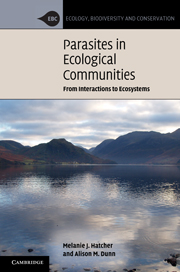Book contents
- Frontmatter
- Contents
- Acknowledgements
- List of abbreviations
- 1 Introduction
- 2 Parasites and competitors
- 3 Parasites and predators
- 4 Parasites and intraguild predation
- 5 Plant pathogens and parasitic plants
- 6 Parasites and invasions
- 7 Ecosystem parasitology
- 8 Emerging diseases in humans and wildlife
- 9 Where do we go from here?
- References
- Index
3 - Parasites and predators
Published online by Cambridge University Press: 05 August 2012
- Frontmatter
- Contents
- Acknowledgements
- List of abbreviations
- 1 Introduction
- 2 Parasites and competitors
- 3 Parasites and predators
- 4 Parasites and intraguild predation
- 5 Plant pathogens and parasitic plants
- 6 Parasites and invasions
- 7 Ecosystem parasitology
- 8 Emerging diseases in humans and wildlife
- 9 Where do we go from here?
- References
- Index
Summary
Introduction
In the preceding chapter we examined the effects of parasites on interactions between members of the same trophic level (intra- and interspecific competition and apparent competition). We can regard the indirect effects in these systems as horizontal ramifications of parasitism; however, parasites can also have vertical ramifications, affecting the interactions between species at different trophic levels. In this chapter, we look at examples of vertical ramifications, examining the role of parasites in predator–prey interactions. Parasites can enter into predation modules in a variety of ways, and their consequences for population dynamics and community structure will depend on their position in the module. We can distinguish modules involving parasites of the prey species, or of the predator species, or of both (Fig. 3.1). These modules may be further differentiated depending on the degree of predator specialisation. For instance, a specialist predator with population dynamics tightly coupled to that of its prey might be expected to be more sensitive to the impact of parasitism on the prey (Section 3.1). Nevertheless, as we examine in Section 3.2, generalist predators may be influenced by, and influence, parasitism of the prey.
Overview of predation modules
We can get some qualitative understanding of the likely impact of parasites by comparing the topologies of different predation–parasitism modules. Parasites that infect the prey species (Fig. 3.1a) are in essence competing with predators; thus the addition of parasites turns this into a competition module (with the prey/host species the resource).
- Type
- Chapter
- Information
- Parasites in Ecological CommunitiesFrom Interactions to Ecosystems, pp. 90 - 140Publisher: Cambridge University PressPrint publication year: 2011

